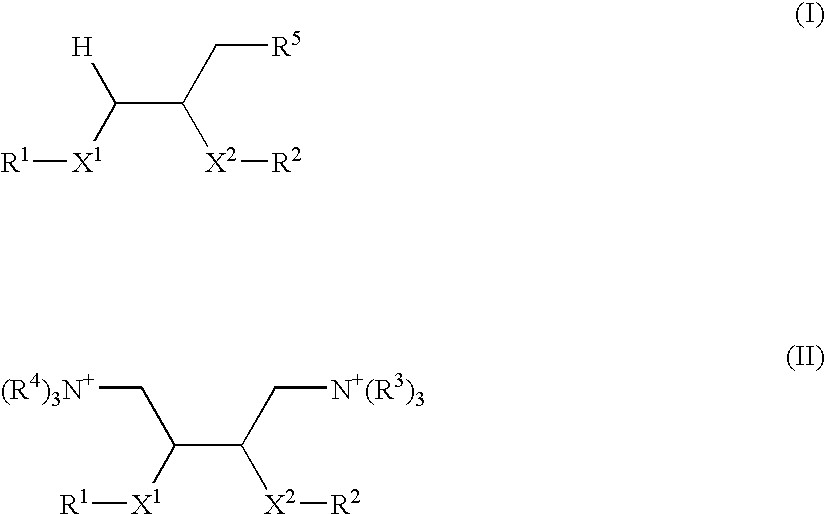Materials for the delivery of biologically-active material to cells
a biologically active material and cell technology, applied in the field of lipids, can solve the problems of toxicity, inflammatory response, difficulty in dealing with large dna fragments, and lower transfection efficiency, and achieve enhanced transfection efficiency, beneficial effect on transfection efficiency, and improved transfection efficiency
- Summary
- Abstract
- Description
- Claims
- Application Information
AI Technical Summary
Benefits of technology
Problems solved by technology
Method used
Image
Examples
example 1
[0272] [2,3-Di-(oleyloxy)-propyl]-(3-bromo-propyl)-dimethyl-ammonium bromide was prepared in a first step:
[0273] 1,2-Dioleyloxy-3-dimethylamino propane (0.50 g, 0.81 mmol) and 1,3-dibromopropane (0.82 ml, 8.10 mmol) were stirred in methanol in a sealed tube at 80° C. for 18 hr. The solvent was removed in vacuo. The product was purified by flash chromatography (gradient; DCM to 10% methanol in DCM) to yield the above product as a yellow oil (0.41 g, 62%).
[0274] Rf=0.17 (5% methanol in DCM); δH (300 MHz, CDCl3) 0.87 (6H, t, J 7.0 Hz, CH2CH3), 1.28 (44H, m), 1.57 (4H, m, OCH2CH2), 2.01 (8H, m, C2CH═CHCH2), 2.45 (2H, m, BrCH2CH2CH2N), 3.40-4.10 (19H, m, CHO, CH2O, NCH3, BrCH2CH2CH2N), 5.33 (4H, m, CH═CH); δC (75 MHz, CDCl3) 14.50 (CH2CH3), 23.00-33.10, 53.25 and 53.56 (NCH3), 65.00 (NCH2), 66.29 (NCH2), 68.87, 69.94, 72.57 and 73.78 (CHO and CH2O), 130.24 and 130.48 (CH═CH); νmax cm−1 (Film) 3417.6, 2923.9, 2852.5, 2358.8, 1633.6, 1463.9, 1120.6;
[0275] The above product was then con...
example 2
[0278] [2,3-Di-(oleyloxy)-propyl]-[2-(2-bromo-ethoxy)-ethyl]-dimethyl-ammonium; bromide was prepared in a first step:
[0279] 2-Bromoethyl ether (278 mg, 1.20 mmol) and 1,2-dioleyloxy-3-dimethylamino propane (300 mg, 0.48 mmol) were stirred in methanol (2 ml) at 90° C. in a sealed tube for 24 hr. The solvent was removed in vacuo. The product was purified by recrystallization (ethyl acetate) to yield the above product as a yellow oil at r.t. and a off white solid upon freezing (197 mg, 48%).
[0280]δH (300 MHz, CDCl3) 0.90 (6H, t, J 7.0 Hz, CH2CH3), 1.25 (44H, m), 1.52 (4H, m, OCH2CH2CH2), 2.01 (8H, m, CH2CH—CHCH2), 3.40-4.10 (23H, m, CH2O, CHO, NCH2, NCH3, CH2Br), 5.34 (4H, m, CH═CH); m / z (ESP+) 773.6 (45%, M+), 772.6 (100%, M+), 771.6 (45%, M+), 770.6 (88%, M+); νmax cm−1 (Film) 3428.2, 2926.8, 2854.0, 2343.8, 1641.8, 1464.8, 1366.5, 1122.0.
[0281] In a second step, the above product was converted to [2,3-Di-(oleyloxy)-propyl]-[2-(2-trimethyl-ammonium-ethoxy)-ethyl]-dimethyl-ammoniu...
example 3
[0284]2-[2-(2-Bromo-ethoxy)-ethoxy]-ethanol was produced in a first step:
[0285] Tri (ethylene) glycol (4.50 g, 30.0 mmol) and hydrobromic acid solution (48%, 5.09 ml, 45.0 mmol) were stirred in toluene (70 ml) at reflux for 72 hr. After cooling the solution was neutralized by the addition of saturated sodium hydrogencarbonate solution. Water (50 ml) was added and the resulting mixture was extracted with DCM (3×50 ml). The chlorinated extract was dried over anhydrous magnesium sulfate and concentrated in vacuo. No further purification was required and the above product was obtained as a yellow oil (2.29 g, 36%).
[0286]δH (300 MHz, CDCl3) 2.64 (1H, s, OH), 3.42 (2H, t, J 6.2 Hz, CH2Br), 3.55-3.65 (8H, m, CH2O), 3.76 (2H, t, J 6.2 Hz, CH2CH2Br); δC (75 MHz, CDCl3) 30.65 (CH2Br), 62.05 (CH2OH), 70.70, 71.51 and 72.93 (CH2O); νmax cm−1 (Film) 3415.7, 2920.0, 2871.8, 2339.5, 1641.3, 1454.2.
[0287] In a second step, the above product was converted to [2,3-Di-(oleyloxy)-propyl]-{2-[2-(2-h...
PUM
| Property | Measurement | Unit |
|---|---|---|
| melting temperature | aaaaa | aaaaa |
| diameter | aaaaa | aaaaa |
| pKa | aaaaa | aaaaa |
Abstract
Description
Claims
Application Information
 Login to View More
Login to View More - R&D
- Intellectual Property
- Life Sciences
- Materials
- Tech Scout
- Unparalleled Data Quality
- Higher Quality Content
- 60% Fewer Hallucinations
Browse by: Latest US Patents, China's latest patents, Technical Efficacy Thesaurus, Application Domain, Technology Topic, Popular Technical Reports.
© 2025 PatSnap. All rights reserved.Legal|Privacy policy|Modern Slavery Act Transparency Statement|Sitemap|About US| Contact US: help@patsnap.com



